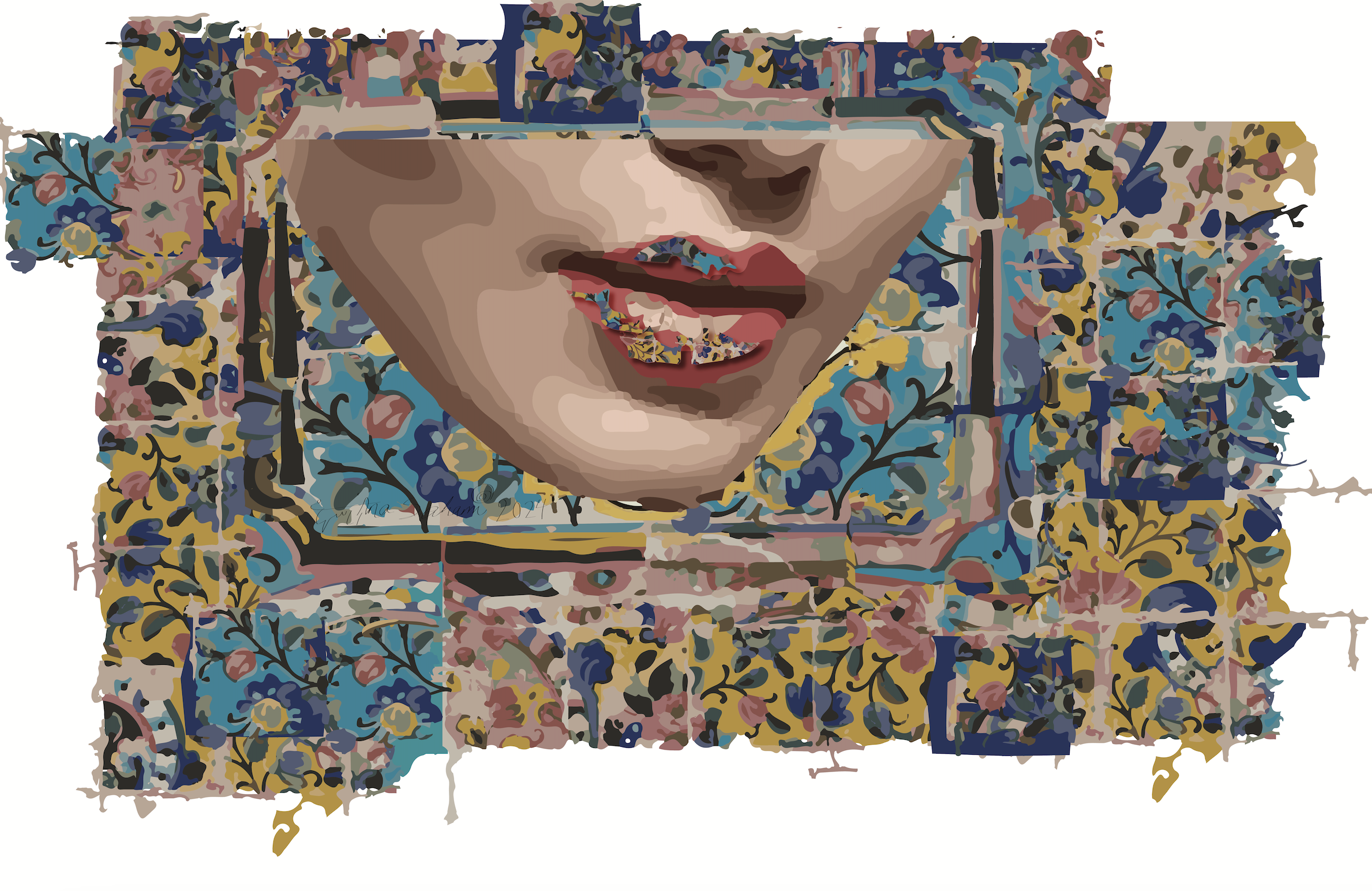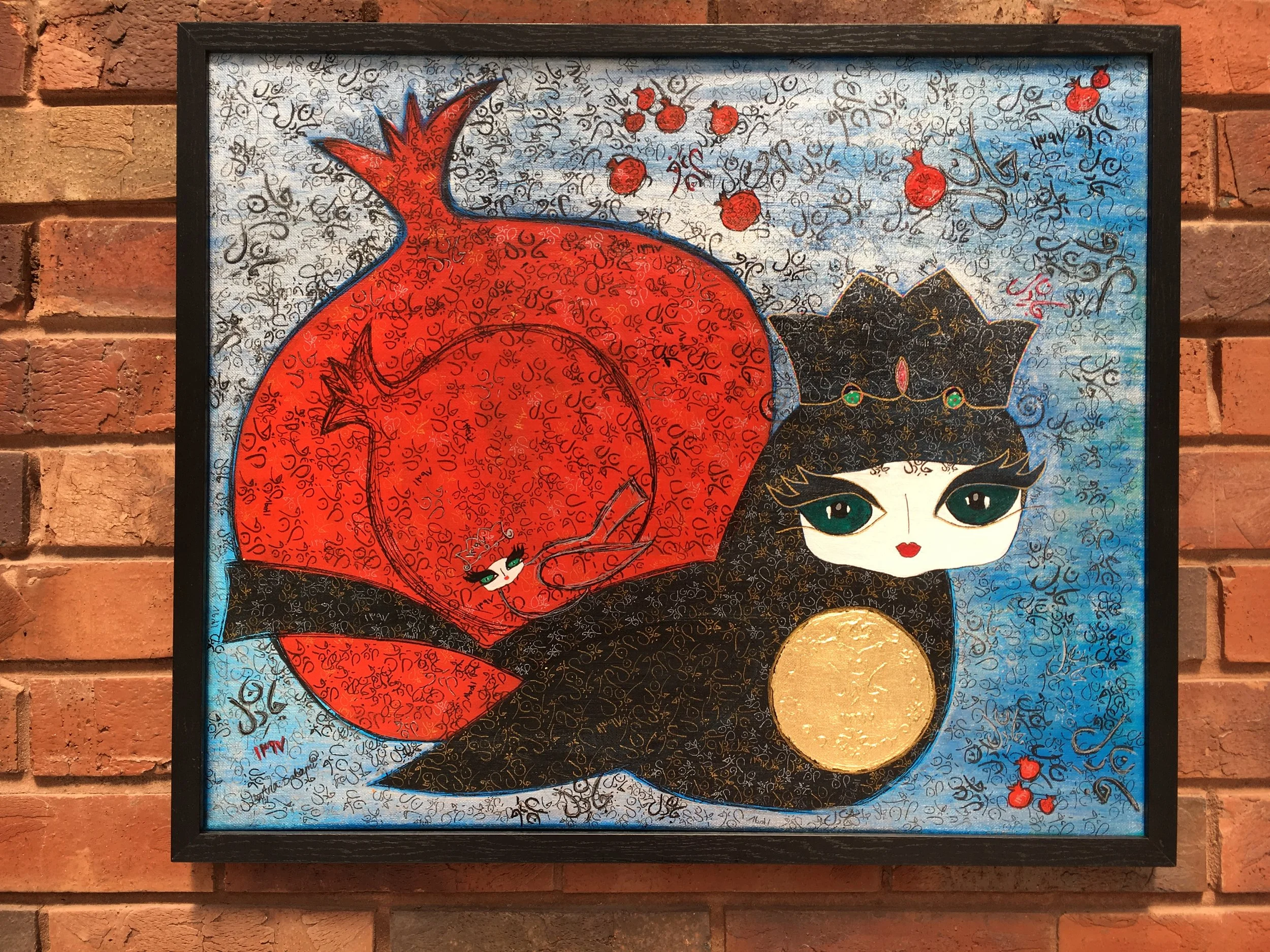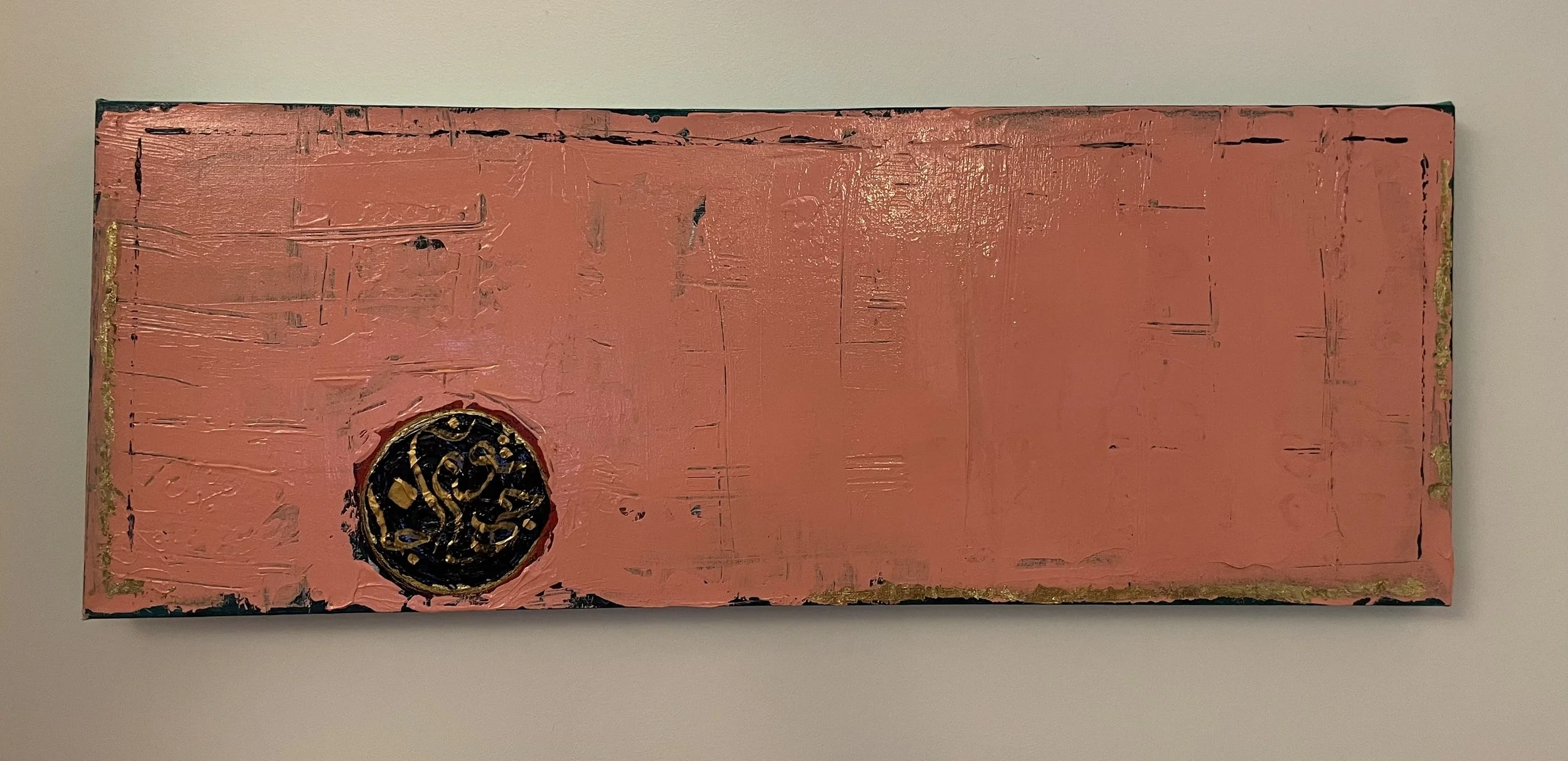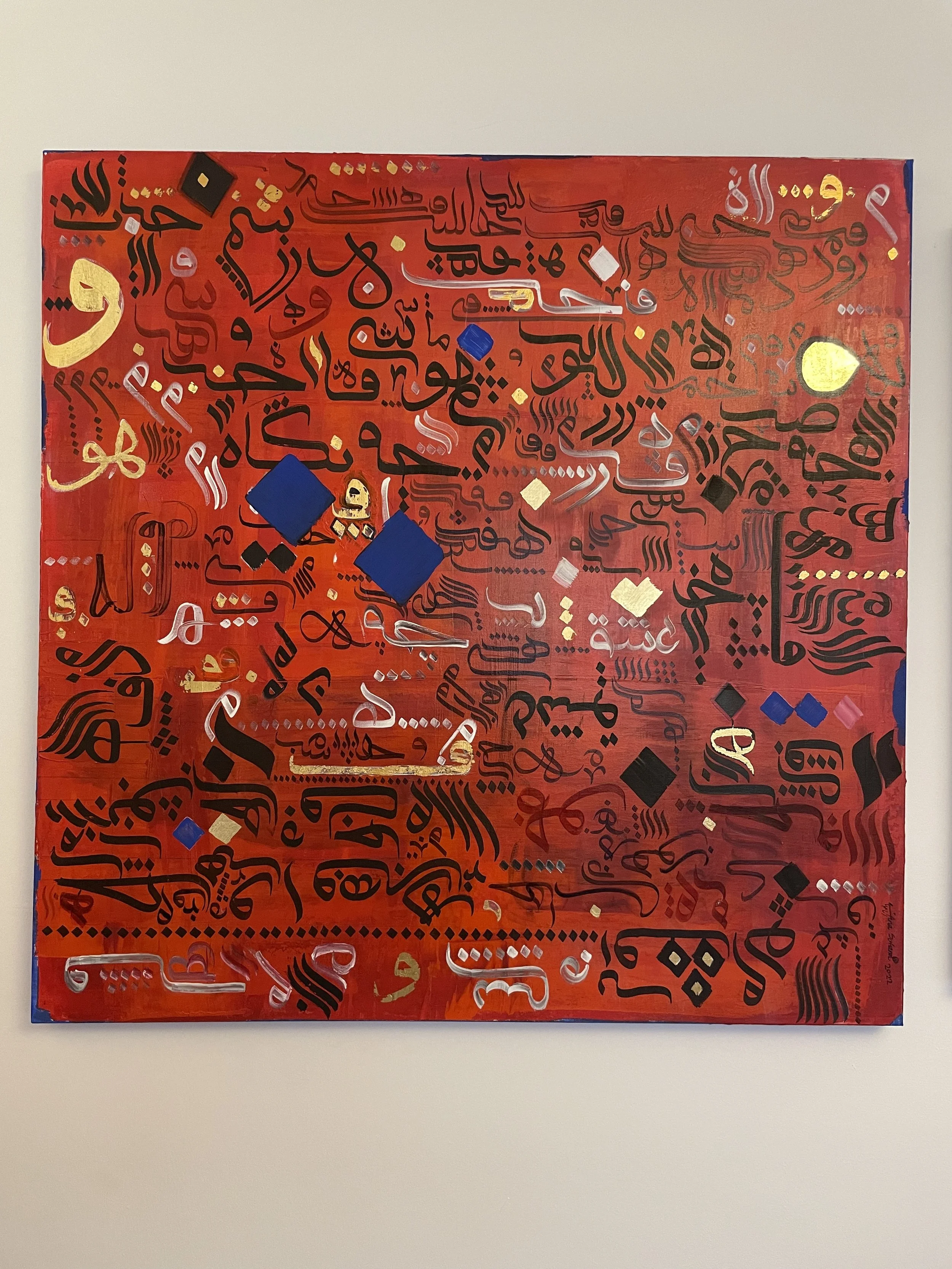Interview with Ana Sahami
In your work, you aim to portray different levels of love. Could you elaborate on how you conceptualize these varying levels in your creative process? How do you ensure that each level is distinct yet contributes to a cohesive narrative within your artworks?
When I think about love, I see it as a multifaceted concept, much like a diamond with its many facets that reflect light differently depending on the angle. Each level of love has its own emotional depth and unique characteristics, ranging from romantic and familial love to platonic, self-love, and even love that is tinged with sorrow or loss. So, when conceptualising these levels in my digital art, paintings and artistic lettering I start by delving into the emotional essence of each type of love.
For instance, if I'm portraying romantic love, I might focus on warmth, intimacy, and tenderness. The visual language here could involve softer lines, flowing shapes, and warmer colour palettes like reds, pinks, and golds to evoke a sense of closeness and passion. On the other hand, when dealing with a theme like platonic love or friendship, I might opt for more vibrant, contrasting colours that represent diversity and the dynamic nature of such relationships. Similarly, for something like love in the face of loss, I may choose muted tones, fragmented shapes, or faded textures to convey a sense of distance and fragility.
Each of these interpretations requires a different approach, and I make a conscious effort to reflect these subtleties in the composition, colour schemes, and overall visual language of my work. But the challenge, is to ensure that each level of love, while distinct, also contributes to a cohesive narrative across the entire collection of artworks.
To achieve this, I rely on a few core thematic elements that run throughout my work. Think of these as the underlying threads that bind the collection together. For instance, I might use a recurring motif—like a particular symbol, shape, or texture—that appears in various forms across different pieces. This creates a visual and thematic continuity without diluting the individuality of each piece. Additionally, I tend to use a consistent style in terms of line work and form. This allows for variation in the portrayal of emotions while maintaining a coherent aesthetic that ties everything together.So, in essence, my creative process involves balancing specificity with universality. Each piece must stand alone, reflecting a distinct "level" of love, but when viewed together, they should tell a larger story about the complexities and nuances of human emotion. It's about creating a dialogue between the artworks—where each speaks in its own voice, yet they all resonate with one another, contributing to a unified emotional and conceptual experience.
Born in Tehran and now based in the UK, how do you think your rich cultural heritage influences your artistic expression? Can you pinpoint specific elements in your art that are directly inspired by Persian aesthetics or Western influences?
That's a fascinating topic and one that's quite close to my heart. Having been born in Tehran and now living in the UK, I feel like my artistic identity is constantly evolving, shaped by a rich tapestry of both Persian and Western influences. Each culture has left a unique imprint on my work, and I find that the interplay between the two creates a compelling narrative in my art.
Starting with Persian aesthetics, I am deeply inspired by the intricate patterns, vibrant colours, and poetic symbolism that are so characteristic of Persian art and culture. Persian miniatures, for instance, have had a profound impact on my use of colour and detail. These miniatures are not just beautiful; they tell stories, evoke emotions, and capture moments in an almost dream-like quality. I often try to bring that same level of storytelling into my work. You might notice intricate, repetitive patterns or floral motifs that echo the gardens of Persia, or the use of gold leaf and deep blues reminiscent of Persian tilework. The concept of "Negargari," the art of Persian miniature painting, greatly influences my approach to composition—especially the idea of layering meaning within a single frame. Another crucial element from Persian culture that inspires me is calligraphy. But instead of traditional calligraphy, I often incorporate nastaliq scripts or reinterpret them through what I referred to earlier as "artistic lettering." The fluidity and grace of Persian calligraphy lend themselves beautifully to digital art and painting, where the written word becomes an extension of the visual narrative. I love to blend these fluid lines with more abstract, modern forms, creating a dialogue between the classical and the contemporary.
As for Western influences, they have introduced me to a different visual language—one that is often more minimalist, conceptual, and grounded in a different approach to space and form. Living in the UK has exposed me to the avant-garde movements of Western art, from modernism to contemporary digital practices. This exposure has encouraged me to experiment more freely with abstraction, negative space, and bold compositions. For instance, while Persian art often fills the canvas with rich details, Western influences have taught me the power of restraint and silence in a piece. Sometimes, the absence of detail can speak just as loudly as an intricate pattern. This is especially apparent in my work that explores more profound emotional themes, where I might juxtapose a Persian-inspired motif with a stark, minimalist background to create a sense of contrast or tension.
So, when you look at my work, you're essentially seeing a fusion of these worlds. A piece might have the delicate pattern work and emotive colour of Persian art but also the balance, conceptual depth, and sometimes the stark simplicity of Western modernism. It's this blending of aesthetics that allows me to create something that feels both deeply personal and universally resonant. My cultural heritage is a continuous source of inspiration, and my work aims to bridge these two worlds, reflecting both where I come from and where I am now.
With your background in graphics and typography, how do you integrate these elements into your paintings without overshadowing the visual storytelling of your art? What challenges have you faced in balancing these disciplines?
Integrating graphics and typography into my paintings is both a passion and a delicate balancing act. My background in these fields has taught me the importance of clarity, structure, and visual hierarchy, but painting brings in a whole different dimension—emotion, texture, and narrative depth. The challenge is to merge these elements in a way that enhances the storytelling rather than overpowering it.
One of my primary approaches is to treat typography and graphic elements as complementary rather than dominant forces within the painting. I see them not as separate additions but as woven threads that are part of the fabric of the artwork. For instance, when incorporating text, I often think of it as a texture or a pattern rather than straightforward lettering. I’ll layer it within the painting, allowing it to merge with the background, fade into the colours, or intertwine with other elements. This way, it becomes a subtle whisper rather than a shout, adding depth without stealing focus.
Additionally, I focus on the emotive quality of typography—how the shape of a letter or the flow of a line can convey mood. Instead of using text for direct communication, I play with its form, often stretching, distorting, or abstracting it until it takes on a life of its own as a visual element. For example, elongated scripts can evoke movement or tension, while bold, blocky type might ground a piece or create a sense of structure. This approach allows the typography to add layers of meaning, inviting viewers to engage more deeply without dictating a specific message.
Graphic elements, such as geometric shapes or bold lines, are also carefully considered. I use them as compositional tools to guide the viewer’s eye, create rhythm, or balance the painting’s overall structure. However, I always ensure these elements work in harmony with the more organic, painterly aspects of the work. By softening the edges or integrating them into the brushstrokes, I prevent them from feeling too stark or disconnected from the rest of the piece.
One of the biggest challenges I face is avoiding the temptation to let the design elements dominate. It’s easy for the precision of graphics and typography to overpower the more nuanced, expressive qualities of a painting. I constantly remind myself that the heart of the artwork lies in its ability to evoke feeling, not just to look visually balanced or technically impressive. I’ve had to learn to step back, sometimes simplifying or reworking sections that feel too design-heavy, to ensure that the emotional core of the painting remains intact.
Another challenge is navigating the expectations of different audiences. Those familiar with graphic design might look for clean lines and crisp execution, while art viewers might seek emotional depth and texture. Balancing these expectations requires a mindful approach—using graphic and typographic elements to enhance the narrative without losing the painterly essence that connects on a deeper level.
Ultimately, integrating these disciplines has taught me a lot about restraint and intention. It’s about creating a dialogue between the structured and the expressive, allowing each element to contribute to the overall narrative without competing for attention. This fusion of art, graphics, and typography adds a unique layer to my storytelling, creating works that feel both contemporary and deeply personal.
Your father's passion for art significantly influenced your career. How do you see your work as a continuation of his legacy, and in what ways do you think your artistic voice diverges from his?
My father’s passion for art was a profound influence on my life, and I see my work as a deeply personal continuation of his legacy. From a young age, he introduced me to the world of creativity and taught me to see art as more than just an aesthetic pursuit—it was a language, a way to connect with the world around me. In that sense, my work is very much a tribute to his influence; it’s my way of carrying forward his love for art, his dedication, and his belief in the power of creativity to tell stories.
I think the continuation of his legacy is reflected in the values he instilled in me: a commitment to craftsmanship, a deep respect for tradition, and an understanding of art as a tool for emotional expression. These principles underpin everything I create. I aim to bring the same level of passion, thoughtfulness, and attention to detail that he inspired in me, making each piece feel purposeful and personal.
However, my artistic voice has naturally diverged as I’ve developed my own identity and embraced my experiences. Living in a different cultural context has shaped my approach, and I often explore themes of identity, displacement, and the blending of cultures in my work. My art reflects a modern, evolving perspective that incorporates digital techniques, experimental forms, and contemporary themes that resonate with today’s audience. It’s a journey of constantly exploring new methods, pushing boundaries, and expressing ideas that are uniquely mine.
There’s also a strong element of introspection in my work that speaks to my own personal experiences and emotions. While my father’s influence is a guiding force, I also see my art as a space to voice my own narratives—stories of navigating between cultures, exploring different forms of love, and the complexities of modern life. It’s this divergence that makes my work feel authentic and allows me to build upon his legacy in a way that’s both respectful of the past and reflective of my present.
In essence, my art is a dialogue between where I come from and where I am now. It’s about honouring the impact my father had on me while embracing the evolution of my own artistic voice. This balance of continuation and divergence is what keeps my work dynamic, meaningful, and deeply personal—a tribute to my roots, but also a declaration of my own journey.
What do you hope your audience feels or thinks when they encounter your art? Is there a particular piece you feel most successfully invokes these intended emotions or thoughts?
My greatest hope is that my art evokes an emotional response, sparking a sense of connection or introspection within the viewer. I want people to feel something when they stand before my work—whether that’s nostalgia, joy, longing, or a moment of quiet reflection. My art often explores themes of love, identity, and the complex interplay between cultures, and I hope it resonates on a deeply personal level, allowing viewers to see a piece of their own stories within it.
I strive to create artworks that feel layered—not just visually, but emotionally. I want the audience to engage with the piece beyond the surface, pausing to find their own meaning in the interplay of colours, forms, and textures. My intention is not to dictate a specific narrative but to provide a space where viewers can explore their own emotions and interpretations. For me, the most rewarding feedback is when someone tells me that a piece has moved them or made them think in a new way. It’s that shared human experience, the silent conversation between the art and the viewer, that I find truly powerful.
One piece that I feel most successfully captures these intended emotions is called “Hidden Murmurs.” It is my personal narrative manifested on canvas—a tale whispered in vibrant hues and shimmering gold leaf. This artwork invites the viewer to explore the secrets concealed within its depths. At its core lies a symbol of passion and emotion, veiled by layers of delicate gold leaf, hinting at the hidden truths obscured beneath the surface.
“Hidden Murmurs” is designed to evoke contemplation, urging viewers to look beyond the visible and consider the unseen whispers that resonate within their own souls. The artwork unveils hidden narratives through the graceful strokes of Farsi handwriting, specifically using the phrase "جانِ دل" (sweetheart or soul-heart). Each letter, meticulously crafted in the language of the soul, speaks volumes about transparency, truth, and the power of revelation. I have used this phrase in most of my artworks, weaving it into the fabric of my visual language to deepen the connection between the art and the viewer.
The use of gold leaf adds a layer of allure and secrecy, reflecting the complexities of human experience—the parts of ourselves that we keep hidden yet shape who we are. “Hidden Murmurs” is an invitation to unravel the mysteries within the piece and, by extension, within oneself, encouraging viewers to find parallels between the art and their own lives.
Through this work, I hope to connect with the audience on a deeper level, allowing them to embrace the beauty of what lies beneath the surface and to see a reflection of their own hidden stories within my art.
Your love for color is evident in your work. Could you discuss how you choose your color palette, and what role do you think color plays in the communication of complex emotions in your art?
Colour is central to my work because it profoundly affects how emotions are communicated. When choosing a colour palette, I consider the emotional tone and message of the piece. For instance, warm, vibrant colours might be used to express passion or joy, while cooler, subdued tones can evoke calmness or melancholy.
I select colours based on their psychological impact and how they interact with one another. The contrasts and harmonies within a palette help highlight different emotional layers and add depth to the narrative. By carefully balancing colours, I aim to guide the viewer’s emotional response and create a more immersive experience.
Colour also plays a crucial role in establishing mood and atmosphere. Through the strategic use of colour, I can emphasise certain aspects of the story or emotional nuance, making the complex feelings I want to convey more accessible and engaging.
Looking forward, are there new themes or techniques you are eager to explore in your future projects? How do you see your art evolving in the next five to ten years, and are there any specific goals you wish to achieve?
In the future, I’m eager to delve deeper into private projects where clients specifically seek me out for my unique style and approach. I want to create art that’s not only visually compelling but also deeply personal and reflective of my distinct artistic voice. My focus is to ensure that each piece I create is unmistakably mine, carrying my signature blend of colour, typography, and emotional depth. I’m excited about the possibility of working closely with clients who resonate with my work, allowing me to craft bespoke pieces that speak to their individual stories, spaces, and identities.
Over the next five to ten years, I aim to build a reputation for delivering personalised art that stands out for its originality and personal touch. I want my work to be easily recognisable and sought after, not just for its aesthetic appeal but for the emotional connection it fosters. To achieve this, I plan to continue refining my techniques, experimenting with new mediums, and pushing the boundaries of how I integrate typography, calligraphy, and painting. I’m particularly interested in exploring more dynamic compositions and mixed media, merging traditional techniques with digital elements to create works that feel contemporary yet timeless.
A significant part of my vision is to enhance my visibility in the art world, establishing myself as an artist known for creating exclusive, one-of-a-kind pieces that reflect a unique blend of cultural influences and personal narratives. I hope to build a strong portfolio of projects and collaborations that showcase my distinct contributions to the art world. This might include limited edition series, curated exhibitions, or special commissions that allow me to bring my creative vision to new audiences.
I’m also keen to explore themes that delve into the human experience more deeply—issues of identity, memory, and the evolving nature of love and connection in our increasingly digital world. I want my work to continue evolving, embracing complexity and nuance, and I’m excited to see where this journey takes me creatively.
Ultimately, my goal is to leave a lasting impact through art that feels authentic, intimate, and true to my vision. By developing a portfolio that highlights the bespoke, personalised nature of my work, I hope to carve out a space in the art world where my pieces are not just admired but deeply valued for the stories they tell and the emotions they evoke.

















